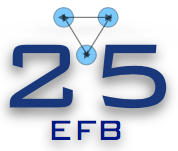Speaker
Description
Extensive research has been conducted in recent years to determine the accurate atomic data and uncertainties associated, as they are crucial for interpreting a large amount of high-resolution data obtained by astrophysicists. In other way, the need for this research is primarily due to the upcoming ITER project (International Thermonuclear Experimental Reactor), which requires precise and complete spectroscopic studies, both experimental and theoretical, to estimate power loss caused by impurities in future fusion reactors [1].
As previously published [2, 3, 4, 5, 6], we continue to study a more complex system, the atomic structure for C-like ions. Energy levels, wavelengths, weighted oscillator strengths and transition probabilities are calculated for the 20 lowest levels of $2s^22p^2$, $2p^4$ and $2s^12p^3$ configurations of C-like ions with Z= 10-22.
The calculations were carried out using in first the GRASP2018 code based on the multiconfiguration Dirac-Hartree-Fock (MCDHF) [7]. To assess the accuracy of results, we performed in parallel other calculations using the FAC (Flexible Atomic Code) code [8] in order to provide theoretically the most accurate data. Transition probabilities are reported for all types of transitions (E1, E2, M1 and M2 transitions). Breit interactions and quantum electrodynamics effects are included in the Relativistic Configuration Interaction (RCI) calculations. Comparisons were made with other data found in the literature and a good agreement was found which confirms the reliability of our results. We identified some new data that are calculated for the first time. This computational approach enables us to present a consistent and improved data set of all important transitions of the Carbon iso-electronic spectrum, which are useful for identifying transition lines in further investigations.
References:
[1] A. J. H. Donne et al., Nucl. Fusion 47 S337 (2007).
[2] D. E. Salhi and H. Jelassi, Canadian Journal of Physics 96 3 (2017).
[3] D. E. Salhi and H. Jelassi, Orient. J. Phys. Sciences. 2 2 (2017).
[4] D. E. Salhi, P. Quinet and H. Jelassi, Atomic Data and Nuclear Data Tables 126 70-157 (2019).
[5] D. E. Salhi, S. Ben Nasr and H. Jelassi, Radiation Physics and Chemistry 177 108817 (2020).
[6] D. E. Salhi, S. Ben Nasr, S. Manai, H. Jelassi, Results in Physics 23 103960 (2021).
[7] C. Froese Fischer, G. Gaigalas, P. Jonsson, J. Bieron, Computer Physics Communications, 237 184 (2019).
[8] M. F. Gu, Canadian Journal of Physics 86 5 (2008).

